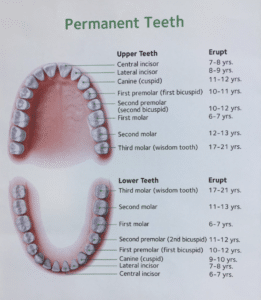Common Questions
Below you’ll find some of the most common questions we receive from parents in our practice. While these may answer some questions you might have, these are general guidelines and every one is unique. We encourage you to give us a call to assist you further should you have any other questions regarding your child or their specific dental needs.
A: The American Academy of Pediatric Dentistry recommends a dental visit by the age of one, or 6 months after the first baby tooth begins to show (erupt). It is recommended that a patient return for biannual visits (twice a year/every six months), however, patients with braces (or other orthodontic work) may even be instructed for more frequent cleanings (every three to four months).
A: The American Academy of Pediatric Dentistry recommends finding a dental home for your child by their first birthday and/or 6 months after the eruption of their first tooth. This visit will be a mostly informative visit while we look gently at your child's tooth and tissues. We will discuss any questions you may have, and cover any relative age-appropriate topics unique to your child and their needs.
The healthcare and oral care of primary (baby) dentition is critical for the proper growth and development of permanent teeth: it is crucial for the child's well-being. The first visit serves as the foundation from which we assess your child and their needs; we begin discussing age-appropriate oral hygiene habits, diet in relation to teeth and overall health, and if applicable, other (but not limited to) topics such as teething, bottle feeding, zippy cups, heredity, thumb sucking, flossing and fluoride use.
Our goal is for you and your child to feel empowered and confident having conquered the first visit to the dentist, and look forward to the next one. We understand that the dental environment can be challenging to patients of any age, and we make it a primary objective to instill comfort and security in our patients by building trust while providing the best standard of care possible.
As the child grows, prior discussions based on the first and subsequent visits serve as the building blocks on which we will expand healthy, preventative, and comprehensive dental care. When appropriate, the use of x-rays, sealants, early orthodontic intervention, and mouth guard as they become engaged in sports will be discussed.
A: It is well documented that children have better experiences with appointments when they are fresher and not tired mentally and physically from their typical daily activities (i.e. appointments in the morning make the dental visit less stressful for the child). A visit to the dentist is not always a comfortable environment, so to ease the experience of the child, coming in earlier is always beneficial.
A: Our practice proudly takes a number of major insurances (PPO plans). Please check with your carrier for more detailed information. Please bring all insurance information with you and understand your coverage. Sometimes procedures your child requires are not covered by your insurance plans. We would like for your entire experience to be easy and comfortable, so we highly recommend becoming familiar with your PPO plan.
A: Fluoride is a naturally occurring element. It has been scientifically proven to effectively make tooth enamel stronger. We recommend the use of a topical fluoride application following your child's cleaning twice a year (every 6 months). Fluoride treatments at the dental visit contain a higher level of concentration to help remineralize and repair weakened enamel and help combat microscopic cavities on the tooth surface.
A: A sealant is a protective barrier applied on the chewing surfaces or grooves of the back teeth. It is designed to help fight "pit and fissure" cavities by making the grooves flatter and easier to clean.
A: While an exam of a person's mouth can give a lot of insight into the patient's teeth, not everything is visible to the naked eye of the dentist. They allow the dentist to see the "whole picture" when it comes to the patient's oral health. They are like the windshield of a car, you wouldn't drive a car with a blacked-out windshield, right?
X-rays are an essential diagnostic tool. Without them, certain dental conditions can and will be missed. Pediatric dentists are very careful to minimize the exposure of their patients to radiation, which is why lead-lined neck and torso aprons are used when taking x-rays in combination with the latest digital technology built to reduce unnecessary radiation exposure.
A: Nitrous oxide is a blend of 2 gases that when inhaled causes a mild soothing effect to the individual inhaling. The use of nitrous oxide/oxygen is a technique used to calm an anxious patient during a dental visit. The patient generally smells a sweet odor and feels a relaxing sensation, while remaining fully conscious and aware of their surroundings. All patients are unique, therefore, some patients may benefit immensely from the use of nitrous oxide/oxygen.
Patients opting for the use of nitrous oxide/oxygen should arrive at the appointment on a 3-hour empty stomach (no food or drink), or they may become nauseous and possibly vomit.

A: Everyone comes with two sets of teeth: their primary (baby) teeth and permanent (adult) teeth. The images above provide a great rough timeline for when primary and permanent teeth erupt (come in) and shed (fall out). It is perfectly normal for variations in this timeline to occur: everyone is different; some individuals even have certain teeth missing!
A: Our office generally leaves a courtesy call to remind families of their appointments at least 48 hours ahead of time. Should you need to reschedule, simply call us at our office with at least 24 hours' notice. Appointments broken within 24 hours may incur a $50.00 charge.
